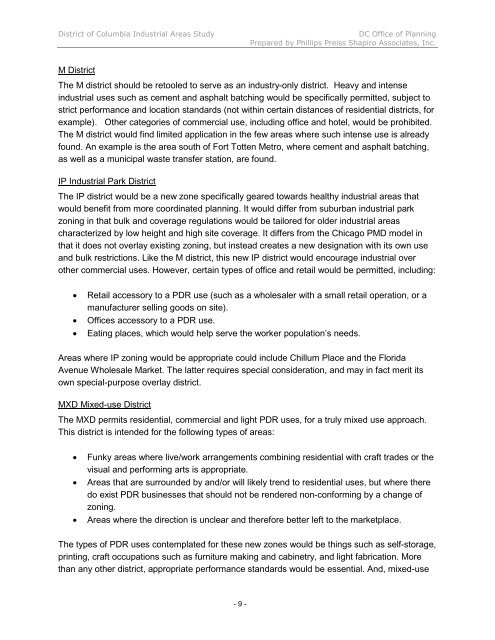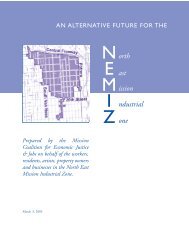INDUSTRIAL LAND IN A POST-INDUSTRIAL CITY District of ...
INDUSTRIAL LAND IN A POST-INDUSTRIAL CITY District of ...
INDUSTRIAL LAND IN A POST-INDUSTRIAL CITY District of ...
You also want an ePaper? Increase the reach of your titles
YUMPU automatically turns print PDFs into web optimized ePapers that Google loves.
<strong>District</strong> <strong>of</strong> Columbia Industrial Areas Study DC Office <strong>of</strong> Planning<br />
Prepared by Phillips Preiss Shapiro Associates, Inc.<br />
M <strong>District</strong><br />
The M district should be retooled to serve as an industry-only district. Heavy and intense<br />
industrial uses such as cement and asphalt batching would be specifically permitted, subject to<br />
strict performance and location standards (not within certain distances <strong>of</strong> residential districts, for<br />
example). Other categories <strong>of</strong> commercial use, including <strong>of</strong>fice and hotel, would be prohibited.<br />
The M district would find limited application in the few areas where such intense use is already<br />
found. An example is the area south <strong>of</strong> Fort Totten Metro, where cement and asphalt batching,<br />
as well as a municipal waste transfer station, are found.<br />
IP Industrial Park <strong>District</strong><br />
The IP district would be a new zone specifically geared towards healthy industrial areas that<br />
would benefit from more coordinated planning. It would differ from suburban industrial park<br />
zoning in that bulk and coverage regulations would be tailored for older industrial areas<br />
characterized by low height and high site coverage. It differs from the Chicago PMD model in<br />
that it does not overlay existing zoning, but instead creates a new designation with its own use<br />
and bulk restrictions. Like the M district, this new IP district would encourage industrial over<br />
other commercial uses. However, certain types <strong>of</strong> <strong>of</strong>fice and retail would be permitted, including:<br />
Retail accessory to a PDR use (such as a wholesaler with a small retail operation, or a<br />
manufacturer selling goods on site).<br />
Offices accessory to a PDR use.<br />
Eating places, which would help serve the worker population’s needs.<br />
Areas where IP zoning would be appropriate could include Chillum Place and the Florida<br />
Avenue Wholesale Market. The latter requires special consideration, and may in fact merit its<br />
own special-purpose overlay district.<br />
MXD Mixed-use <strong>District</strong><br />
The MXD permits residential, commercial and light PDR uses, for a truly mixed use approach.<br />
This district is intended for the following types <strong>of</strong> areas:<br />
Funky areas where live/work arrangements combining residential with craft trades or the<br />
visual and performing arts is appropriate.<br />
Areas that are surrounded by and/or will likely trend to residential uses, but where there<br />
do exist PDR businesses that should not be rendered non-conforming by a change <strong>of</strong><br />
zoning.<br />
Areas where the direction is unclear and therefore better left to the marketplace.<br />
The types <strong>of</strong> PDR uses contemplated for these new zones would be things such as self-storage,<br />
printing, craft occupations such as furniture making and cabinetry, and light fabrication. More<br />
than any other district, appropriate performance standards would be essential. And, mixed-use<br />
- 9 -












